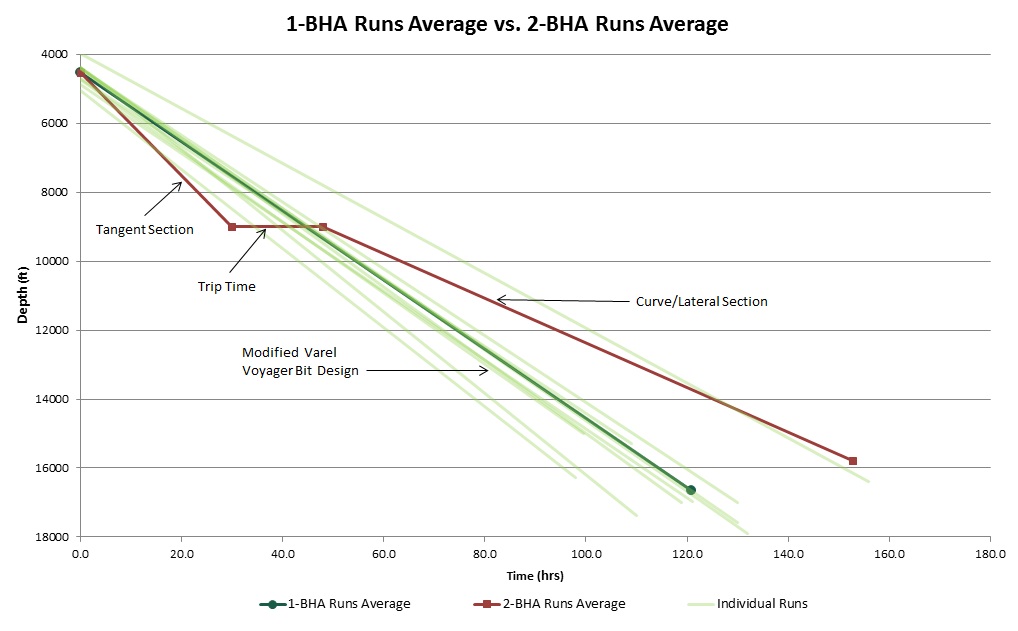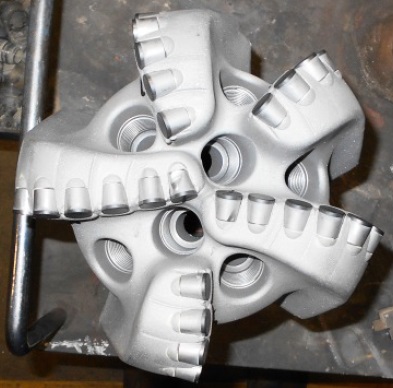A fixed-cutter bit designed to drill tangent, curve and lateral sections in a single run is improving the economics of Eagle Ford wells by cutting trips and bottomhole assembly (BHA) costs. Wells in Atascosa and McMullen counties, Texas, typically require multiple bits plus changes in motor and MWD components to drill all three sections. The costs can be significant. In addition to BHA expenses, a single round trip takes about 18 hours.
A bit was needed that could drill all three sections in a single run using one BHA. A Varel Voyager bit designed for directional drilling was optimized for the task by precisely balancing speed and durability demands in each of the three sections.
In addition to significant time and cost savings, the bit is achieving true “factory drilling” consistency in both drilling time and wellbore quality.
Drilling three sections in one run
While the low compressive-strength sands and shales in the Eagle Ford make minimal demands on bit durability, changes in formation and hole geometry create unique requirements. Drilling the tangent, curve and lateral sections typically requires trips for at least two bits and BHA, which adds considerable time and expense to each hole.
In offsets, an average 1,359-m (4,457.7-ft) tangent section was drilled in 29.8 hours at 45.6 m/hr (149.58 ft/hr) ROP; the average curve/lateral section of 2,067 m (6,780.6 ft) was drilled in 104.9 hours at 19.7 m/hr (64.63 ft/hr). The three combined sections (3,426 m [11,238.3 ft]) were drilled in an average 134.7 hours at 25.4 m/hr (83.4 ft/hr), but the addition of an 18-hr round trip resulted in an overall offset average of 152.7 hours and an overall ROP of only 22.4 m/hr (73.6 ft/hr).
Eliminating the trip plus BHA costs had a significant impact on performance. The first 10 runs of the Voyager bit used a single bit and BHA to drill all three sections for an average 3,697 m (12,125.4 ft) drilled in 120.8 hours at 30.6 m/hr (100.38 ft/hr).

Balancing demands
Eliminating a trip or two and the associated BHA costs required development of a bit that could effectively drill all three sections in a single run. The inherent challenge was balancing each section’s different formation characteristics and wellbore geometry demands to produce a bit that would optimize overall performance.
Varel used proprietary modeling and design software to determine the best combination of bit features and characteristics for the one bit/one BHA application.
The design started with a 7 7/8-in. Voyager V513GH fixed-cutter bit developed for directional drilling applications. The model is designed to support modifications that optimize performance for the specific application. Its basic design includes additional nozzles and contoured blades to support increased hydraulics and minimize erosion.
The bit also features thermally stable polycrystalline diamond elements throughout the gauge to enhance durability. Three different gauge configurations provide options for modifying directional behavior, which makes the bits broadly compatible with various directional drive systems.
For the single-run Eagle Ford wells, the objective was to balance the speed and durability required in the tangent and lateral sections with the demand for speed and steerability in the curve section. In this application, the curve is the most demanding section and requires the most specific bit design. Durability in the tangent/lateral section had to be optimized within the requirements of drilling the curve section.
Design changes ranged from modifications of the basic cutting structure to fine-tuning that altered back rake, side rake and torque limitations. Changes included varying cutter exposure to limit torque fluctuations and improve toolface consistency. Gauge requirements, which vary dramatically in each of the hole sections, also were modified, along with the cutting structure.

Modeling software solution
Proprietary bit modeling software was used to determine the optimal gauge selection based on directional objectives. Voyager gauge options provide alternatives for conventional, rotary steerable, positive displacement motor and point-the-bit rotary steerable system (RSS) assemblies as well as push-the-bit RSS and push-the-bit, high dogleg severity (DLS)/3-D sidetracking RSS.
The modeling software allowed designers and field engineers to specifically address the multiple formations encountered in the single-run application. The program employs advanced algorithms, rock analytics and extensive field operating and performance data to determine how changes in bit features and dimensions will affect a range of characteristics—including steerability, bit walk, DLS capability and vibration control—for a particular well trajectory and BHA.
Proprietary SPOT design software was used to lay out the cutting structure so that torque values were optimized based on the various formation and drilling characteristics. The software improves design flexibility by modeling the cutting structure to improve steering control by finding the optimal balance between speed and stability.
Geoscience rock analytics used in this process model bit behavior in various rock types. This was fundamental to predicting bit wear when drilling the multiple formations encountered in the single-run application.
Field operations
The first two modified 7 7/8-in. V513H bits successfully drilled the tangent, 90-degree curve and lateral sections. The first bit drilled 3,680 m (12,072 ft) at 30.5 m/hr (100 ft/hr), while the second bit drilled an outstanding 4,121 m (13,517 ft) at 31.2 m/hr (102.4 ft/hr).
A second design iteration done to toughen the bit added more cutters and diamond elements in the gauge. This version successfully completed its tangent, curve and lateral to total depth (TD), drilling 3,955.8 m (12,975 ft) at 36 m/hr (118 ft/hr), which still stands as the best run. Wear conditions were very good with a dull grade of 1-0-WT-N-X-In-NO-TD.
Drilling performance enhancement
Ten Voyager bit runs have been made to date. The bits have drilled an average 3,696 m (12,125.4 ft) at an average ROP of 30.6 m/hr (100.38 ft/hr), spud to TD. The performance of the design enabled a process change that eliminated multiple trips for bit and BHA changes in tangent, curve and lateral sections.
By balancing durability and steering requirements, the Varel bit enabled drilling the entire well with a single bit and BHA, eliminating a trip and associated BHA costs.
In addition, consistency in drilling time and hole quality was improved, benefiting the overall efficiency of the pad drilling operations.
Recommended Reading
Oil Jumps 4% After Trump Pauses Tariffs on Many Countries, Raises China Levy
2025-04-09 - Oil prices bounced back after U.S. President Donald Trump said he would further increase tariffs on China but pause the tariffs he announced last week for most other countries.
Oil Prices Fall into Negative Territory as Trump Announces New Tariffs
2025-04-02 - U.S. futures rose by a dollar and then turned negative over the course of Trump's press conference on April 2 in which he announced tariffs on trading partners including the European Union, China and South Korea.
Oil Prices Extend Losses on Global Trade War, Recession Fears
2025-04-04 - Investment bank JPMorgan said it now sees a 60% chance of a global economic recession by year-end, up from 40% previously.
E&P Execs Level Scathing Criticism at Trump's Drill Baby Drill 'Myth'
2025-03-26 - E&P executives pushed back at the Trump administration’s “drill, baby, drill” mantra in a new Dallas Fed survey: “’Drill, baby, drill,’ does not work with [$50/bbl] oil,” one executive said.
Trump to Host Top US Oil Chief Executives as Trade Wars Loom
2025-03-19 - U.S. President Donald Trump will host top oil executives at the White House on March 19 as he charts plans to boost domestic energy production in the midst of falling crude prices and looming trade wars.
Comments
Add new comment
This conversation is moderated according to Hart Energy community rules. Please read the rules before joining the discussion. If you’re experiencing any technical problems, please contact our customer care team.

